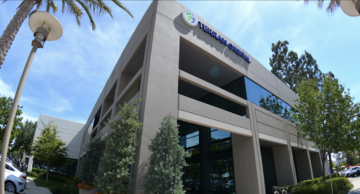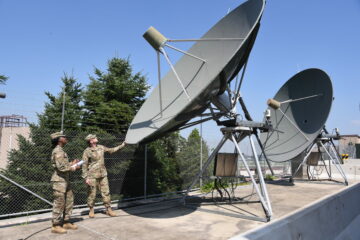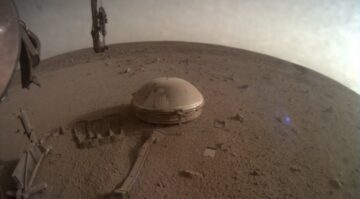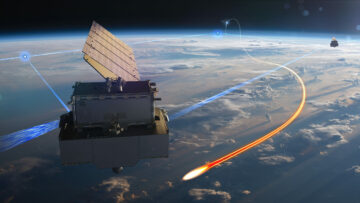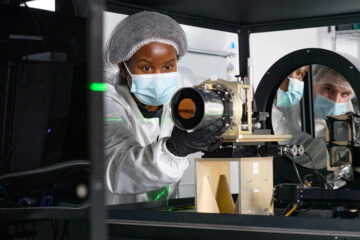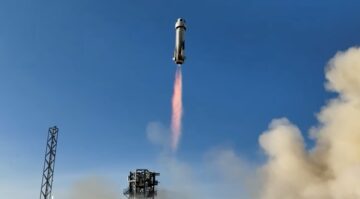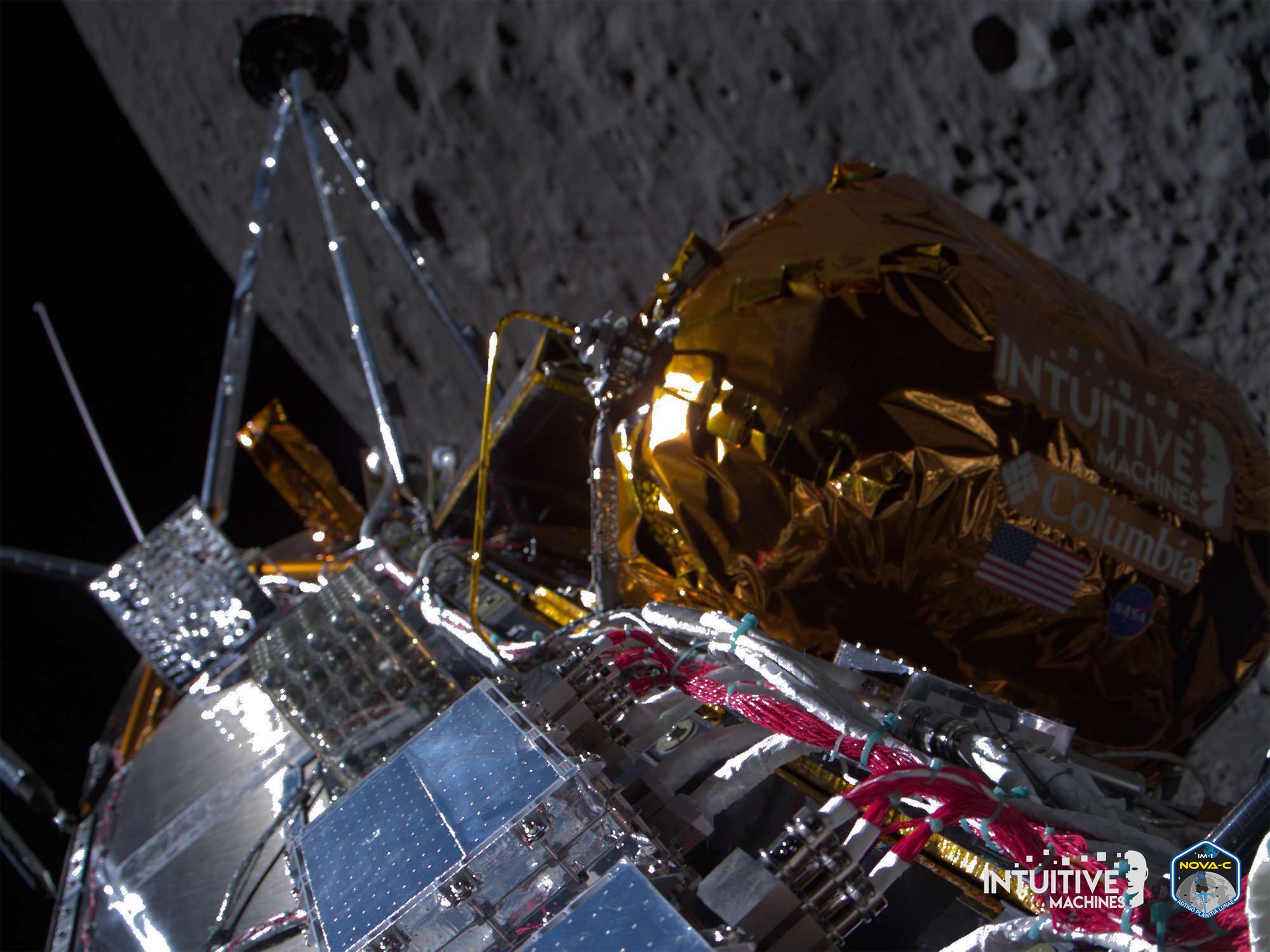
WASHINGTON — A robotic lander developed by Intuitive Machines landed safely on the moon Feb. 22, becoming the first privately developed spacecraft to touch down on the moon and the first American spacecraft to do so in more than half a century.
The Nova-C lander, named Odysseus, landed on in the south polar regions of the moon at 6:23 p.m. Eastern on the IM-1 mission. It took about 15 minutes after landing for controllers to confirm they were receiving a signal from the lander on the surface, getting only a weak signal initially.
“What we can confirm, without a doubt, is our equipment is on the surface of the moon and we are transmitting,” Tim Crain, Intuitive Machines flight director for the landing attempt, said. “So, congratulations, IM team.”
Intuitive Machines delayed the landing by two hours to perform an additional orbit of the moon. The company said that it determined that laser rangefinders on the lander, a key instrument to enable a precise landing, were not working properly. Controllers uploaded a software patch to enable to the lander to use in their place use a NASA Doppler lidar payload originally intended to be a technology demonstration.
“Basically, it is the primary system to help provide the velocity and altitude information,” said Prasun Desai, NASA deputy associate administrator for space technology, of the NASA payload during the landing broadcast.
Odysseus lifted off Feb. 15 on a SpaceX Falcon 9, which placed the spacecraft on trajectory to the moon. After a commissioning maneuver to test the spacecraft’s liquid oxygen and methane engine, it performed two trajectory correction maneuvers before going into low lunar orbit Feb. 21.
The landing was the first on the moon by a privately developed spacecraft. It was also the first soft landing on the moon by any American spacecraft since the last Apollo mission, Apollo 17, in December 1972.
The IM-1 mission carried six NASA payloads through the agency’s Commercial Luar Payload Services (CLPS) program, under a task order awarded in 2019 and valued, after revisions, at $118 million. The payloads emphasized technology demonstrations, including a navigation Doppler lidar, a navigation beacon, a radiofrequency fuel tank gauge and a camera to study dust plumes kicked up by the lander’s engine. Other NASA payloads included a laser retroreflector and a radioastronomy instrument.
IM-1 also carried six non-NASA payloads. Columbia Sportswear provided material identical to what it uses on some of its jackets to test its use as insulation for a propellant tank. Two companies, Galactic Legacy Labs and Lonestar Data Holdings, flew data archives on the lander. The International Lunar Observatory Association flew two small astronomical cameras. Artist Jeff Koons provided an artwork called “Moon Phases” installed on the lander.
The most ambitious of the non-NASA payloads was EagleCam, built by students at Embry-Riddle Aeronautical University. EagleCam was designed to be ejected from the lander during its final descent, reaching the surface ahead of the lander and taking images of the lander’s touchdown.
Three private missions attempted to land on the moon before IM-1 and all failed. In April 2019, the Beresheet lander, built by Israel Aerospace Industries for Israeli organization SpaceIL, crashed on its final descent to the lunar surface when one of its inertial measurement units malfunctioned, causing a “cascade of resets” in spacecraft avionics that shut down the main engine.
In April 2023, HAKUTO-R M1, a lander developed by Japanese company ispace, also crashed on its final approach to the moon. The company determined that the onboard computer disregarded altitude information from a sensor as the lander passed over a crater rim, thinking the sensor malfunctioned, leading it to conclude the lander was on the surface when it was still five kilometers above it.
Astrobotic, which also had a NASA CLPS award, launched its Peregrine lander Jan. 8 on the first ULA Vulcan Centaur rocket. However, the lander suffered a propellant leak hours after liftoff, which Astrobotic believes may have been caused by a malfunctioning valve that overpressurized and burst a tank. The leak forced Astrobotic to call off the landing attempt, and Peregrine burned up in the atmosphere when it returned to Earth a week and a half after liftoff.
NASA had adopted a “shots on goal” approach to CLPS when the agency started the program more than five years ago, accepting that some missions would fail. “NASA leadership remains committed and continues to accept the risk that some of these missions might not succeed,” Chris Culbert, NASA program manager for CLPS, said at a Jan. 31 briefing.
“We knew going into this that it’s a really, really difficult thing to do when we decided to go down this path, and it might turn out they’re not all going to be successful, particularly some of the earliest ones,” Joel Kearns, deputy associate administrator for exploration in NASA’s Science Mission Directorate, said in an interview before the launch of Peregrine.
He argued that there would not be a retrenchment, either at NASA or within industry, should early missions fail. “The companies we believe, are in it for the long term. We think it’s the best path to get U.S. industry to do this as a service rather than for us to do it ourselves.”
- SEO Powered Content & PR Distribution. Get Amplified Today.
- PlatoData.Network Vertical Generative Ai. Empower Yourself. Access Here.
- PlatoAiStream. Web3 Intelligence. Knowledge Amplified. Access Here.
- PlatoESG. Carbon, CleanTech, Energy, Environment, Solar, Waste Management. Access Here.
- PlatoHealth. Biotech and Clinical Trials Intelligence. Access Here.
- Source: https://spacenews.com/intuitive-machines-lands-on-the-moon/
- :is
- :not
- ][p
- $UP
- 15%
- 17
- 2019
- 2023
- 21
- 22
- 23
- 31
- 6
- 8
- 9
- a
- About
- above
- Accept
- accepting
- Additional
- adopted
- Aerospace
- After
- agency
- ago
- ahead
- All
- also
- ambitious
- American
- an
- and
- any
- apollo
- approach
- April
- archives
- ARE
- argued
- artist
- artwork
- AS
- Associate
- Association
- At
- Atmosphere
- attempt
- attempted
- award
- awarded
- BE
- beacon
- becoming
- been
- before
- believe
- believes
- BEST
- Briefing
- broadcast
- built
- burned
- by
- call
- called
- camera
- cameras
- CAN
- carried
- caused
- Century
- Chris
- Columbia
- commercial
- committed
- Companies
- company
- computer
- conclude
- Confirm
- continues
- crain
- Crashed
- data
- December
- decided
- Delayed
- deputy
- designed
- determined
- developed
- difficult
- Director
- do
- doubt
- down
- during
- Dust
- earliest
- Early
- earth
- eastern
- either
- emphasized
- enable
- Engine
- equipment
- exploration
- FAIL
- Failed
- falcon
- Falcon 9
- Feb
- final
- First
- five
- flight
- For
- forced
- from
- Fuel
- gauge
- get
- getting
- Go
- going
- had
- Half
- Have
- help
- Holdings
- HOURS
- However
- HTTPS
- identical
- images
- in
- included
- Including
- industries
- industry
- information
- initially
- installed
- instrument
- intended
- International
- Interview
- into
- intuitive
- Israel
- Israeli
- IT
- ITS
- Jan
- Japanese
- jpg
- Key
- kilometers
- knew
- Labs
- Land
- landing
- lands
- laser
- Last
- launch
- launched
- Leadership
- leading
- leak
- Legacy
- lidar
- Lifted
- Liquid
- Long
- Low
- Lunar
- Machines
- Main
- manager
- material
- May..
- measurement
- methane
- might
- million
- minutes
- Mission
- missions
- Moon
- more
- most
- Named
- Nasa
- Navigation
- observatory
- of
- off
- on
- Onboard
- ONE
- ones
- only
- or
- Orbit
- order
- organization
- originally
- Other
- our
- ourselves
- out
- over
- Oxygen
- particularly
- passed
- Patch
- path
- perform
- performed
- Place
- placed
- plato
- Plato Data Intelligence
- PlatoData
- polar
- precise
- primary
- private
- Program
- properly
- provide
- provided
- rather
- reaching
- really
- receiving
- regions
- remains
- RETRENCHMENT
- revisions
- Risk
- Robotic
- rocket
- s
- safely
- Said
- Science
- service
- Services
- should
- shut
- Shut down
- Signal
- since
- SIX
- small
- So
- Soft
- Software
- some
- South
- Space
- spacecraft
- SpaceX
- started
- Still
- Students
- Study
- succeed
- successful
- suffered
- Surface
- system
- taking
- tank
- Task
- team
- Technology
- term
- test
- than
- that
- The
- their
- There.
- These
- they
- thing
- Think
- Thinking
- this
- Through
- Tim
- to
- took
- touch
- trajectory
- TURN
- two
- u.s.
- under
- units
- university
- uploaded
- us
- use
- uses
- valued
- valve
- VeloCity
- vulcan
- was
- we
- week
- were
- What
- when
- which
- within
- without
- working
- would
- years
- zephyrnet

